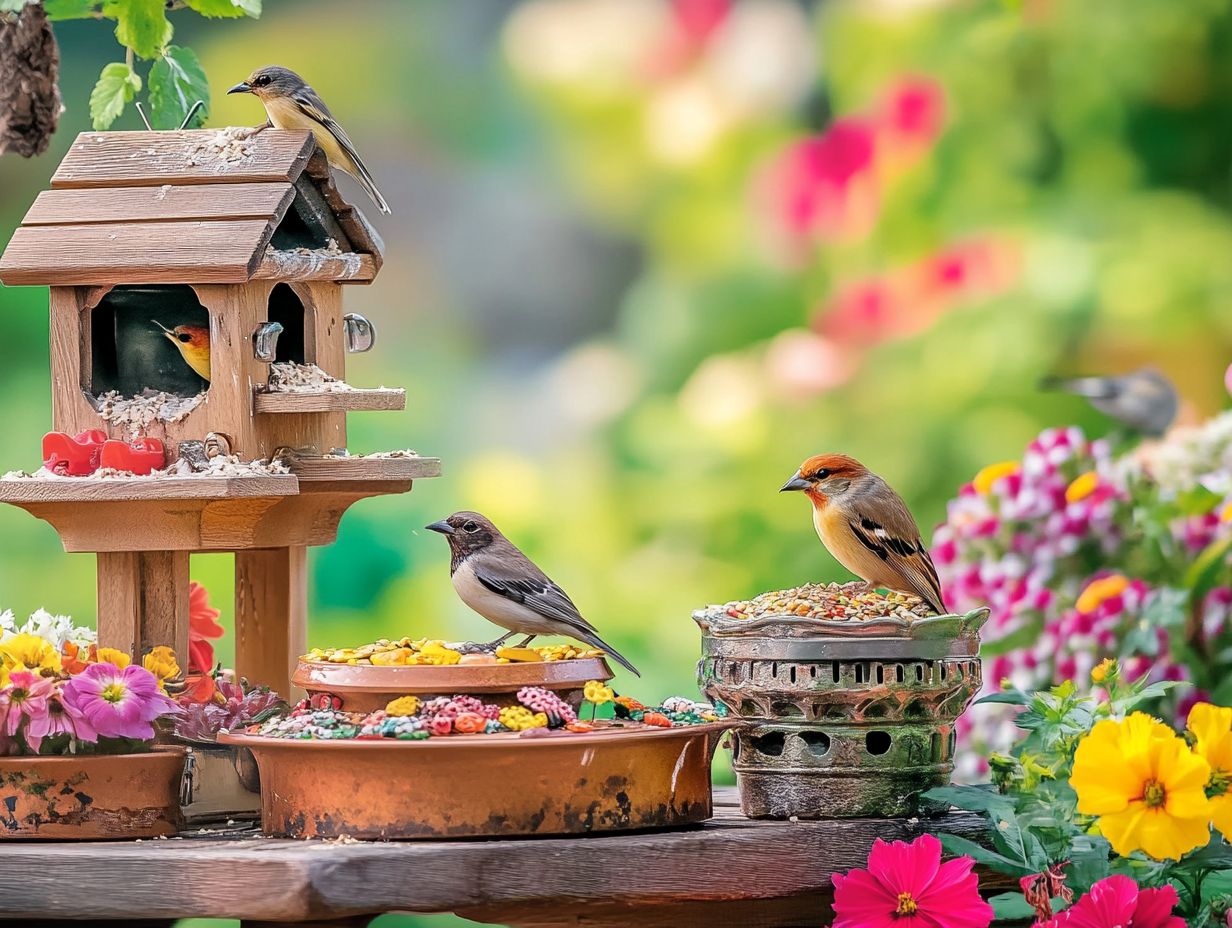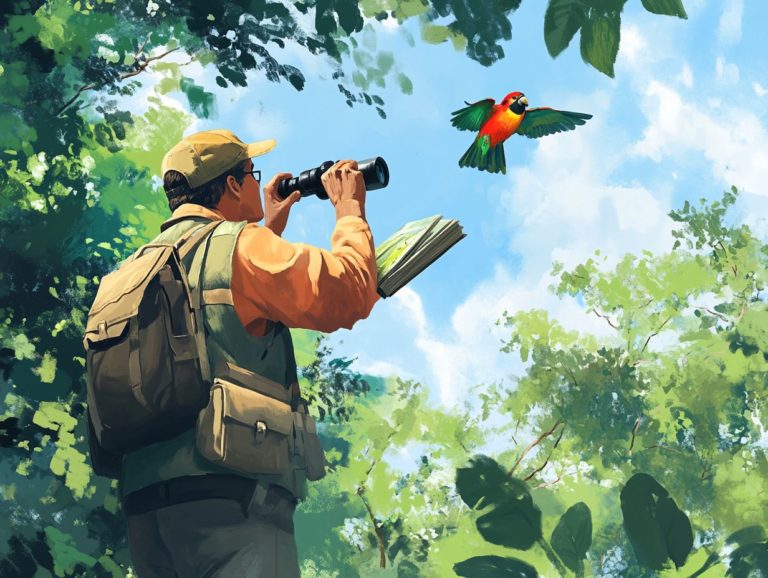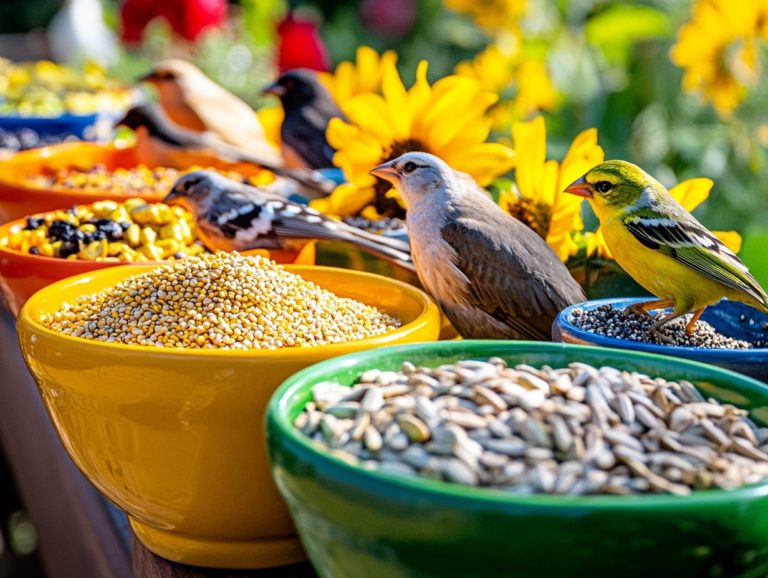How to Choose the Right Bird Feeder?
Bird feeding has the power to transform your outdoor space into a vibrant sanctuary, drawing in a delightful array of feathered visitors.
To elevate your experience, it s vital to understand the diverse types of birds and their unique feeding habits. This knowledge will guide you in selecting the perfect feeder.
Discover the perfect feeders that will attract stunning birds to your yard! This guide outlines the essential factors to consider when making your choice and offers practical tips for their upkeep.
Whether you re just starting out or you re a seasoned bird enthusiast, you ll uncover valuable insights that will enhance your birdwatching experience.
Contents
- Key Takeaways:
- Understanding Bird Feeding Basics
- Factors to Consider When Choosing a Bird Feeder
- Types of Bird Feeders Available
- Tips for Maintaining and Cleaning Bird Feeders
- Frequently Asked Questions
- Want to attract more birds? What factors should you consider when choosing a bird feeder?
- Which feeder is best for attracting specific types of birds?
- How do I find a bird feeder that fits my budget?
- What is the best location to place a bird feeder?
- Are certain materials and designs better for bird feeders?
- Can I make my own bird feeder?
Key Takeaways:

- Consider the location and climate when choosing a bird feeder to attract specific types of birds.
- Different feeder designs and features cater to different bird species and their feeding habits.
- Regular cleaning and maintenance of bird feeders is important to prevent contamination and attract more birds.
Understanding Bird Feeding Basics
Understanding the fundamentals of bird feeding is essential for you as a bird watcher or backyard bird enthusiast. This knowledge aims to create an inviting haven for local avian species.
By familiarizing yourself with the various types of feeders and the dietary preferences of birds like chickadees, cardinals, and doves you can attract a diverse array of species to your yard.
Knowing the seasonal feeding habits, especially winter feeding techniques, can elevate your bird-watching experience, making it both rewarding and educational. Organizations such as the Cornell Lab of the Study of Birds and Audubon provide invaluable resources for anyone interested in this fulfilling hobby.
Types of Birds and Their Feeding Habits
Different species of birds showcase distinct feeding habits that influence the types of feeders and food you should consider for your backyard. For example, chickadees and cardinals prefer sunflower-seed tube feeders, while finches enjoy nyjer seed found in thistle feeders.
Grasping these habits is essential for attracting a diverse array of backyard birds, including doves, orioles, and even hummingbirds, each with specific dietary preferences.
You might notice intriguing behaviors that reveal their likes and dislikes. For instance, jays often cling to feeders and relish acorns, making platform feeders a worthwhile addition. On the other hand, orioles are irresistibly drawn to sugary delights like nectar or orange slices, frequently seen perched on their specially designated fruit feeders.
Meanwhile, the swift movements of warblers as they dart between branches in search of insects can guide you toward setting up suet feeders stocked with high-fat snacks that many backyard birds enjoy.
Understanding these traits elevates your backyard birdwatching experience and ensures that you cater to the unique needs of each feathered visitor.
Factors to Consider When Choosing a Bird Feeder
Selecting the ideal bird feeder is essential for attracting a vibrant array of birds to your backyard. To enhance your efforts, you should consider what you need to know about bird feeding, as numerous factors such as design, location, and climate significantly influence your success.
If you’re in an area with a squirrel population that s more enthusiastic than your feathered friends, choose squirrel-proof feeders to keep your bird food safe for the species you intend to attract.
The type of feeder you select whether it’s a hopper feeder, tray feeder, or suet feeder can determine which birds grace your garden, including those ground feeders that draw in species preferring to forage at ground level, such as squirrels.
By understanding these dynamics, you can elevate your bird feeding experience to new heights! Get started on your bird feeding adventure right now and watch your backyard come alive!
Location and Climate
The location and climate of your backyard are crucial when it comes to attracting birds. Different species have their own habitat preferences and feeding needs, so consider the availability of natural food sources, shelter, and water. For instance, placing feeders in spots with good visibility and close to trees can draw in a variety of backyard birds. This enhances your bird-watching experience.
Understanding seasonal changes can significantly boost the diversity of species visiting your feeders. In winter, providing high-energy foods like suet is particularly beneficial. During warmer months, a mix of seeds and nectar can cater to various preferences.
Pay attention to local wildlife patterns. Position your feeders where they re easily accessible while also offering some cover from predators. By creating an inviting backyard environment with a blend of native plants and water sources, you ll attract more birds and encourage them to stick around longer. This ensures a delightful bird-watching experience.
Feeder Design and Features

Feeder design and features are important in determining which birds grace your backyard and how effective your bird feeding setup will be. For example, squirrel-proof feeders, designed to keep squirrels away, can keep those pesky critters at bay, ensuring that your food remains accessible to delightful visitors like orioles and hummingbirds.
If you opt for window feeders, you ll love the thrill of up-close birdwatching! It’s a captivating experience! Meanwhile, tray feeders provide versatile options that cater to a variety of species.
Every type of feeder presents its unique advantages and disadvantages, tailored to specific bird species and their feeding habits. Tube feeders are fantastic for attracting small songbirds, giving them a safe perch to enjoy their seed, although they might discourage larger birds like blue jays. In contrast, platform feeders attract a wider variety of birds, from sparrows to pigeons, but they may also attract unwelcome pests.
Choosing the right feeder elevates your bird feeding experience and fosters a more diverse avian population in your garden. For insights on what to consider, check out understanding bird feeder preferences. You can enjoy the delightful sights of different species visiting your backyard.
Types of Bird Feeders Available
A diverse range of bird feeders awaits you, each catering to different bird species and their unique feeding preferences. For a comprehensive overview, refer to the ultimate guide to bird feeder types. Choosing wisely is key to ensuring a successful bird feeding experience.
If you opt for platform feeders, you ll create an inviting space for ground feeders. Hopper feeders are excellent for seed storage and attracting a delightful variety of species. If you want to lure in insect-loving birds, suet feeders are your best bet. Tube feeders are perfect for those charming finches and other small birds.
When the warmer months roll around, don t forget hummingbird feeders filled with nectar to attract those vibrant creatures. Also, consider oriole feeders that offer specialized food options!
Platform Feeders
Platform feeders serve as an exceptional choice for attracting ground feeders and a delightful variety of backyard birds. With their flat surfaces, these feeders allow multiple birds to dine simultaneously, creating a lively scene right outside your window. They are versatile, accommodating a range of foods from seeds to fruits, appealing to different species.
By utilizing platform feeders, you invite a diverse array of birds and encourage social feeding behaviors among them. This means birds eating together, which is common among many species. Think about common food options like sunflower seeds, suet cakes, and even mealworms. These treats can attract both charming finches and striking blue jays.
To maximize their effectiveness, position your feeders at varying heights and close to natural shelters such as shrubs or trees. This thoughtful approach creates a welcoming environment for your feathered visitors. By selecting the right location and offering a mix of enticing foods, you can enjoy the mesmerizing sight of numerous birds, transforming your backyard into a vibrant avian sanctuary!
Hopper Feeders
Hopper feeders are expertly crafted for storing and dispensing seeds. They are a wonderful choice for attracting delightful birds like cardinals and chickadees, especially when sunflower seeds are on the menu.
With their generous capacity, you won t need to refill them as often. This consistency encourages repeat visits from these charming birds and appeals to a wider range of species, including finches and jays, who enjoy a varied diet.
By maintaining a well-stocked hopper feeder filled with high-quality seed blends think millet and safflower you provide essential nutrients that support birds during both breeding and migratory seasons.
For optimal efficiency and hygiene, regularly clean your feeders and reposition them as needed to keep pests at bay. A thoughtful mix of seeds can promote a healthier avian population, while strategic placement near natural shelter will attract an even broader array of birds. This enriches your experience as a bird watcher.
Suet Feeders
Suet feeders are a fantastic way to attract insect-eating birds, especially during the colder months when natural food sources can be limited. Providing suet can entice species like woodpeckers and nuthatches, transforming your winter feeding into a truly rewarding experience.
These feeders serve as an important food source for birds such as chickadees and titmice, who rely on high-energy foods to sustain themselves when temperatures drop. Using suet in winter supports local bird populations and creates a lively wildlife experience right outside your window.
To maximize their effectiveness, hang suet feeders in sheltered spots, ideally near trees or shrubs that offer protection from harsh weather and potential predators. Incorporating additional seeds or fruit can elevate your offerings, attracting a broader variety of birds and providing an engaging spectacle for birdwatchers throughout the snowy months.
Tube Feeders

Tube feeders are expertly crafted for dispensing small seeds, like nyjer, making them exceptionally effective at attracting finches and other small birds. Their design minimizes seed spillage and allows multiple birds to feed comfortably together.
These feeders typically feature several feeding ports, enabling multiple birds to visit at once. This design reduces competition and stress among them. A variety of seeds works wonderfully in tube feeders; nyjer is a favorite among species like goldfinches, while sunflower hearts and safflower can draw in a diverse array of feathered visitors.
To enhance your birdwatching experience, position the feeders in peaceful spots near natural cover, such as shrubs or trees. Regular cleaning and timely seed replenishment are crucial for maintaining a healthy feeding environment, preventing spoilage, and attracting even more delightful guests to your backyard.
Hummingbird Feeders
Hummingbird feeders brimming with nectar are essential for drawing in these enchanting birds, especially during migration seasons. Their bright colors and specially designed feeding ports capture hummingbirds, encouraging them to visit frequently.
Setting up a feeder can transform your garden into a vibrant sanctuary, enriching its beauty and supporting local wildlife. To prepare the perfect nectar, mix four parts water with one part granulated sugar; boiling it ensures safety and purifies the mixture. Once it cools, filling the feeder correctly is crucial.
For the best results, position your feeder near flowering plants, ideally sheltered from harsh winds, to maximize feeding activity. Maintaining a clean feeder and regularly replenishing the nectar will create an inviting oasis for these charming creatures, ensuring they return to enchant you throughout the season.
Tips for Maintaining and Cleaning Bird Feeders
Proper maintenance and cleaning of bird feeders are essential for safeguarding the health of the birds you attract. Neglecting this task can lead to contamination and disease, posing risks to your feathered visitors.
By regularly cleaning your feeders with safe techniques, you cultivate a healthier feeding environment that supports the well-being of the birds and encourages them to return frequently.
Set up your feeder today and watch your garden come alive with birds!
Proper Cleaning Techniques
Implementing proper cleaning techniques for your bird feeders is essential to maintaining a healthy feeding station and ensuring the safety of visiting birds. Regular cleaning eliminates mold, bacteria, and pests that can harm these delightful creatures, promoting a thriving environment in your backyard.
Clean your feeders at least every two weeks. Use a mixture of diluted vinegar or warm, soapy water for the best results. For feeders that hold nectar, like hummingbird feeders, frequent cleaning is crucial ideally every week to prevent fermentation and mold growth. Soaking removable parts in a sanitizing solution is particularly effective for reaching those tricky areas.
By adopting these thorough cleaning routines, you not only protect your feathered friends from potential illnesses, but you also enhance the overall ecological balance of your backyard.
Preventing Contamination and Pests
Preventing contamination and pests is critical for maintaining your bird feeders. These issues can deter your feathered friends from visiting and pose health risks to them. By implementing preventive steps, you’ll keep your feeding station clean and inviting for a delightful variety of backyard birds.
One effective strategy is to place your feeders wisely, avoiding locations that collect moisture or sit too close to dense vegetation where pests thrive. Selecting high-quality, bird-specific food helps minimize waste and spoilage, further reducing the risk of contamination.
Establishing a regular cleaning routine emptying and washing your feeders with a suitable disinfectant will prevent mold growth and discourage unwanted visitors. When you consistently apply these practices, you not only create a safer environment but also cultivate a diverse range of bird species, adding vibrancy to your backyard sanctuary.
Frequently Asked Questions

Want to attract more birds? What factors should you consider when choosing a bird feeder?
When choosing a bird feeder, consider the type of birds in your area, your budget, the location and placement of the feeder, and the design and materials of the feeder.
Which feeder is best for attracting specific types of birds?
Different types of feeders attract different types of birds. For example, tube feeders are good for small birds, while platform feeders are better for larger birds. Hopper feeders are effective for attracting a variety of birds.
How do I find a bird feeder that fits my budget?
Bird feeders can range in price from a few dollars to several hundred dollars. Consider how much you re willing to spend, and do some research to find affordable options that meet your needs.
What is the best location to place a bird feeder?
The best location for a bird feeder is one that is easily accessible for birds but also safe from predators. It should also be easy for you to refill and clean.
Are certain materials and designs better for bird feeders?
Bird feeders come in various materials and designs. Choose durable, weather-resistant materials and designs that are easy for birds to access and comfortable for them to perch on.
Can I make my own bird feeder?
Yes, there are many DIY bird feeder ideas and instructions available online. Just make sure to use appropriate materials and follow safety guidelines to ensure the feeder is safe for birds and will last a long time.





